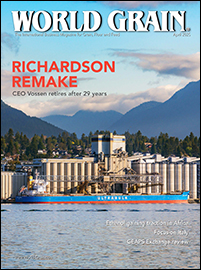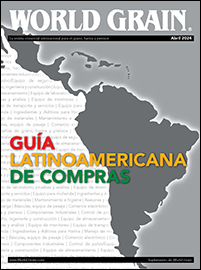KANSAS CITY — When it comes to wheat, there are many approaches to assessing quality, including protein content, enzymatic activity and even physical properties. What may be high quality for one application may not be for another, making valuation of flour complicated for even the most experienced baker. It is, however, paramount for bakers to be aware of variations from one flour shipment to the next to ensure batch-to-batch consistency.
“Quality and consistency in ingredients are crucial to baking,” said Reuben McLean, senior director of quality and regulatory, Grain Craft. “A main ingredient, such as flour, can affect the operational efficiency of a bakery if the flour characteristics from bag to bag or load to load do not remain consistent. Variability in baked goods can be found in a range of attributes such as tolerance to dough processing, end-product volume, symmetry and crumb structure.”
Consider two different products, both made from wheat flour: the bagel, which has a dense, chewy consistency, and cake with its aerated texture. The bagel and cake are on opposite ends of the spectrum when it comes to sensory attributes, yet the main ingredient in both products is wheat flour, just not the same wheat flour.
Wheat comes in six different classes in the United States: hard red winter, hard red spring, hard white, soft red winter, soft white and durum. These are defined by color, hardness and growing season and have a range of quality characteristics that are used for flours.
Certain types are well-suited for pastas and noodles while others are more suited for confectionary products. It’s important for bakers to think about the end result when choosing the appropriate flour.
“Understanding the baking process and recipe formulations of specific products can help bakers choose the appropriate flour for flavor and texture expectations,” said Rob Ostrander, director of technical solutions, Ardent Mills. “For example, whole wheat flour is milled from the entire kernel of wheat, whereas all-purpose flour is produced from the finely ground part of the wheat kernel’s endosperm.
“The presence of bran in whole wheat flour reduces gluten development, causing baked goods to be denser than those made from all-purpose flour.”
In contrast, cake flours tend to be lower in protein and higher in starch, which imparts a delicate texture for cakes and cookies. For bakers, choosing a suitable flour is a crucial step to ensure baked goods meet quality standards.
“Bakers should first identify the texture and flavor profile they are expecting from their baked goods,” Ostrander explained. “From there, they can evaluate the protein content of different flour options to meet those expectations. Protein content can impact the functional properties of the flour and doughs/batters, including water absorption, cohesiveness, dough strength, texture, loaf volume and crumb grain.”
Gluten is an elastic substance that forms when two proteins — glutenin and gliadin — are mixed with moisture. These two proteins bind water and connect and cross-connect to form elastic strands of gluten. These proteins are found in all forms of wheat, including durum, semolina and spelt, as well as other grains, such as rye, oats and barley.
Gluten development is not as important in some baked foods. Therefore, lower protein flours may be used in such applications.
Protein content can impact functional properties of flour when made into dough or batter. Affected properties include water absorption, cohesiveness, dough strength, texture, loaf volume and crumb. But it’s not just protein content that matters; it’s also the levels and distribution of individual protein fractions, mainly gliadin and glutenin, in the wheat, as well as growing conditions and milling method and treatments.
“Achieving quality and consistent flour starts long before the wheat enters the mill,” McLean explained. “At Grain Craft, we work closely with growers to promote Grain Craft Preferred Varieties. These are wheat varieties that have been thoroughly tested and selected based on key milling and baking characteristics.
“Wheat quality is largely impacted by two factors: the environment and the genotype, or variety. Grain Craft Preferred Varieties allow us to reduce variability in flour performance even during years where there may be significant environmental challenges.”
The percent of protein content is dependent on the type of wheat milled. It is also the foundation for purchasing but is not a reliable index of the flour’s baking performance. The quality of the protein is genetically determined. In wheat varieties that are grown under comparable environmental conditions, a high-quality wheat will produce good bread over a broad range of protein levels, but a poor-quality wheat will generally result in low-quality bread, even if the protein content is higher.
“Protein quality relates to the flour characteristics that make it suitable for baking,” said Dave Kovacic, technical service, Bay State Milling.
Key characteristics include gluten quality attributes, such as strength during mixing and fermentation, as well as process tolerance. A quality flour has the ability to perform under varied environmental or mechanical conditions. For bread flours, this also includes the ability to bind with and hold water, the strength of the gluten to hold gas and the ability to provide loaf volume.
A bakery might want to change its formula for cost savings, but a change may mean a significant adjustment to the process.
“To achieve the nuances between different types of baked goods, it’s important to choose not only the right level of protein, but also the quality of protein best suited for the product,” said Josh Reasoner, milling technical service manager, ADM. “Cakes and pastries, for example, ordinarily use a soft wheat flour. They will be sensitive to a change in protein, both quantity and quality. The flour included in a cookie, on the other hand, is more of a vessel for the sugars, fat and other elements in the formulation.”
Managing variations in flour quality can sometimes just require small changes to processes or formulation.
“If bakers are thinking about switching flours or looking for flour to meet their new desire quality characteristics, they should reach out to their flour supplier to talk through options,” Ostrander said. “While that could mean using a new flour product, bakers might also find that small changes to their current process or formulation can make significant differences in the final baked good.”






